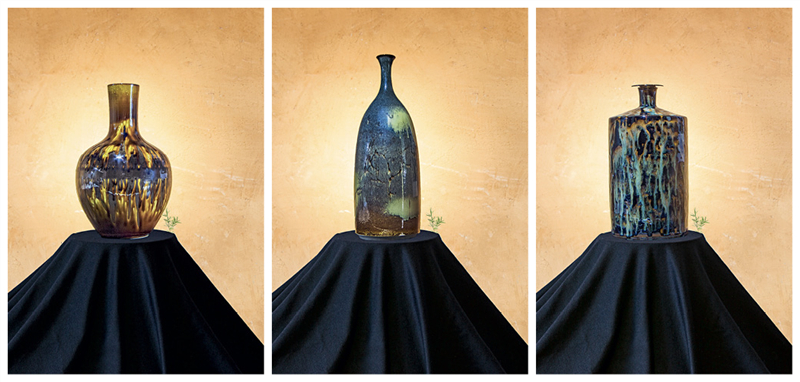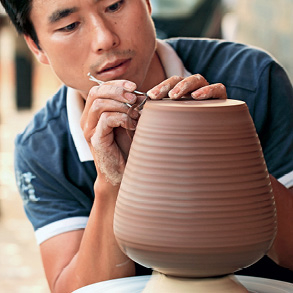
Delicate black pottery items made by Wu Yingfang.
In 2011, a 4,500-year-old black pottery wine vessel, called gu, was discovered in the Laohudun archaeological site in Jing’an County, Jiangxi Province in south China, known for the earliest Neolithic cremation tombs in China.
It wasn’t just any pottery. It was thin as eggshell, and shining black from inside to outside. Eggshell black pottery – “as thin as paper, yet as hard as porcelain, with a clear and melodious sound, and a surface shiny like patent leather” – represents the pinnacle of pottery making techniques in the Neolithic age in ancient China. It is praised around the world as the most exquisite production of human civilization 4,000 years ago.
The thinnest part of the gu is only 0.4 millimeters. But unfortunately, due to the loss of skills and limited information on the ancient firing techniques, the art disappeared after some time. However, thanks to the efforts of the local authorities and an expert artisan, it has now been revived. The story of the art is now inextricably bound with the Wu family of Jing’an, a family that has been potters for generations.

Having mastered the art of black pottery, Wu Yingfang loves to innovate and experiment.
Trans-Generational Relay
Jing’an has a long history of pottery-making. The flames in some kilns are thought to be burning nonstop for generations. In the Wu household, the family business was started over a hundred years ago by a patriarch called Wu Fenqing, a skilled potter especially good at building traditional kilns. One of his descendants, Wu Xianchong, inherited the family skills and could build kilns before he was 20. He passed on his skills and knowledge to his son Wu Yingfang.
“When I was a little boy, I would often go to the pottery factory where my dad worked,” Wu Yingfang said. “My jaw would drop when I saw how mud was turned magically into all kinds of beautiful potteries over fire.”
Taught by his father, Wu began making small jars at the age of six. He showed great talent and at the age of 17 became an official apprentice of his father, mainly learning how to make black pottery. He had a big ambition: “I want to make the most lustrous black pottery with the most perfect shape and beautiful design that would stun everyone.”
In his career as a master potter for over 30 years, Wu has won many honors, such as national model worker, provincial intangible cultural heritage inheritor, and high-level leading talent in Jiangxi. Under him, the family business has grown, with his sons also joining in. His eldest son Wu Shi is now a county-level intangible cultural heritage inheritor.
“After graduating from college, I chose to go back home to inherit my father’s skills. My younger brother also made the same decision after graduating from Jiangxi Arts and Ceramics Technology Institute,” Wu Shi said.

Wu Yingfang at work.
Reviving a Lost Art
Wu Yingfang had never learned to make eggshell black pottery though he comes from a potter family and is an expert at making black pottery. Soon after the discovery of the 4,500-year-old gu, a local official of Jing’an urged him to revive the art of eggshell black pottery. “At first, I thought it would be very simple,” Wu said. “If the ancient people could make it with rudimentary tools, why can’t I with today’s better tools and better skills?”
But when he tried making the exquisite pottery, he faced many challenges. Since the production technique of eggshell black pottery had been lost for thousands of years, there was neither information available nor experiences to follow. So he had to explore on his own. To find the most suitable clay, he scoured the entire area and, after repeated experiments, finally discovered a natural clay that was highly malleable, free of harmful substances, and suitable for making black pottery.
The next step was to craft the vessel from clay. As the pottery is as thin as eggshell, all the extra clay has to be pared off from the initially formed vessel with a knife till it becomes paper-thin. Wu described the difficulty of the task: “If your hand shakes even slightly, or you take a deep breath, or make any small unnecessary movement, it would break and all the efforts you have made so far would be in vain.” But finally in 2019, he was able to successfully fire a black pottery goblet just like the gu, with the thinnest part only 0.2 mm thick.
During the firing process, Wu followed three basic principles: using natural non-toxic materials instead of chemical additive agents, using a handmade kiln and firewood. Ultimately, he managed to fire totally black pottery over natural wood.
“Reviving eggshell black pottery has taught me the value of simplicity,” he said. “During the production process, I have completely stopped using raw chemical materials, only using the cleanest natural ones. Like the ancient people, I converse with nature and seek inspiration from it.”
Once he had resurrected the ancient technique, he began to innovate. For example, he raised the temperature of the kiln from 600-900 degrees Celsius to over 1,280 degree Celsius, achieving a degree of ceramicization. This means that even without glaze, the black pottery still looks glossy. In 2017, the production technique of Jing’an black pottery was listed as a provincial-level intangible cultural heritage item, and Wu was recognized as its representative inheritor.

The Xiangtian Jing Kiln in Jing'an County, Jiangxi Province.
Social Inheritance
Ceramic enthusiasts and workers flock to Wu to admire his creations and learn from him. He gives the example of a persevering young woman who started coming from Beijing in 2016 to learn how to make black pottery under him. She comes every summer and can now make black pottery and black glazed porcelain items.
Wu also teaches ceramic courses as a guest professor at multiple universities. He appreciates the strong support given by the local governments to revive Jing’an black pottery, especially in helping build infrastructure and publicity. Jing’an has built an academic center, an intangible cultural heritage exhibition hall, and a research base to showcase the ancient black pottery.
“As our country gives great importance to traditional culture, I am glad to see more and more young people inheriting the traditional craft,” Wu said.